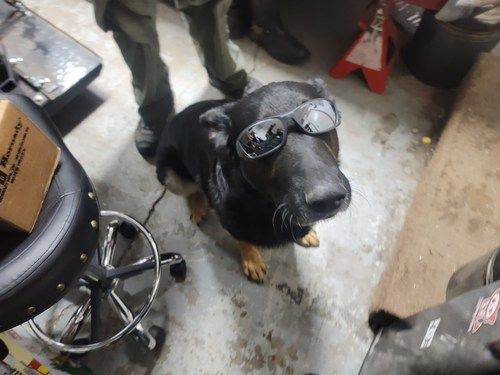German shepherd exposed to lethal substance
This Toxin Tails installment was highlighted for March because the case number—3141592—matches the mathematical number of pi.
Duke enjoys joining his pet parent at his job, though on 1 occasion, the German shepherd was exposed to toxic industrial coolant (Photo courtesy of the Pet Poison Helpline).

It was another day for Nolan Jenkins, from Grande Prairie, Alberta, Canada, as his 8-year-old German shepherd—Duke—accompanied him at his job managing equipment used for natural gas compression. However, during this outing, a coolant line rupture forming a puddle. Though Duke was exposed to this toxic liquid, Jenkins was unsure if he ingested it.
Jenkins decided to call the Pet Poison Helpline as a safety measure when he arrived home.
"One of the first things our toxicology experts do in a case like Duke's is to determine how much of the potential toxin would need to be ingested to be considered a lethal concern based on the type and size of pet we're evaluating," said Renee Schmid, DVM, DABVT, DABT, a senior veterinary toxicologist at Pet Poison Helpline, in an organizational release.1
The Pet Poison Helpline informed Jenkins that just 2 to 3 tablespoons of this coolant were enough to cause death in a dog Duke’s size. "Since I didn't know how much, if any, he had ingested, the experts at Pet Poison Helpline recommended I take him in for analysis and possible treatment,” he said.
According to the release,1 industrial coolant—like consumer vehicle anti-freeze—includes ethylene glycol, which can cause gastrointestinal upset, renal failure, central nervous system damage, and possibly death if ingested. Clinical signs are often seen as early as a half-hour after ingestion but can be postponed for up to 12 hours. Therefore, aggressive treatment early on is required to prevent lethal effects.
When Duke arrived at Animal Medical Centre North, the veterinary team performed blood work to analyze his serum osmolality. Animals with ethylene glycol poisoning will have an increased serum osmolality, but luckily Duke's results were within the normal range, according to the release.1
Additionally, they performed a urinalysis to identify if calcium oxalate crystals were present, a clinical sign consistent with ethylene glycol poisoning that typically signifies a poor prognosis.
"Since Duke's serum osmolality was within the normal reference range, and there was a lack of calcium oxalate crystals seen in the urinalysis, it was unlikely that Duke ingested a lethal amount of the coolant. The hospital team determined no immediate treatment was necessary and they sent him home for further monitoring,” commented Schmid, in the release.1
Schmid remarked that Duke was fortunate he didn’t ingest a fatal amount of the substance. She also commended Jenkins for calling the Pet Poison Helpline and taking Duke to the veterinary hospital for his pet's safety and peace of mind.
Every call the Pet Poison Helpline receives is assigned a unique case number and for Duke, it was 3141592—coincidentally, the same as the mathematical number of pi.
"Since National Pi Day is March 14, and our experts relied heavily on math to determine his risk of concern, we thought it was appropriate to highlight Duke as our March Toxin Tails case," said Schmid.
Reference
German shepherd exposed to deadly industrial coolant - case number matches pi. News release. Pet Poison Helpline. March 10, 2022. Accessed March 10, 2022. https://www.prnewswire.com/news-releases/german-shepherd-exposed-to-deadly-industrial-coolant---case-number-matches-pi-301496260.html